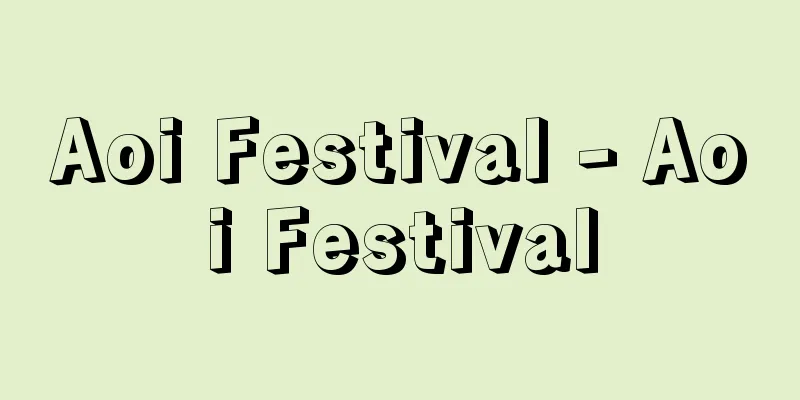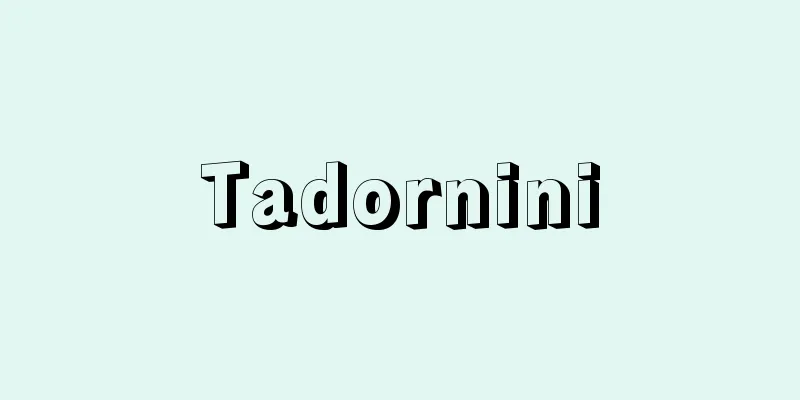Aoi Festival - Aoi Festival

|
This festival is held on May 15th at Kamo Wakeikazuchi Shrine (Kamigamo Shrine) in Kamigamo, Kita Ward, Kyoto City, and Kamo Mioya Shrine (Shimogamo Shrine) in Shimogamo, Sakyo Ward. Originally called Kamo Matsuri, it was so famous that in the Heian period, the Kamo Matsuri was the only festival that came to mind. It was also called Kita Matsuri, in contrast to the Minami Matsuri, which is held at Iwashimizu Hachiman Shrine (Yawata City, Kyoto Prefecture). Even today, it is one of the three major imperial festivals, along with Iwashimizu Matsuri and Kasuga Matsuri. Before the Meiji period, the festival was held on the day of the rooster in the middle of April (in the year of the second rooster, it was held on the day of the lower rooster). The name of the Aoi Festival comes from the practice of using hollyhocks in the headwear of festival attendants and decorating shrines and homes with hollyhocks as a sign of abstinence; a similar name is also found in the Matsuo Festival (held at Matsuo Taisha Shrine in Arashiyama Miyacho, Nishikyo Ward, Kyoto City, from the day of the Rabbit in late April to the day of the Rooster in early May). The Kamo Festival did not appear in the Taiho (701-704) Shinto Law, and was not listed as a medium-level festival until 819 (Kōnin 10) during the reign of Emperor Saga. However, the Shoku Nihongi (Chronicles of Japan Continued) records that the Kamo Kuni Matsuri, performed by the Yamashiro Kokushi on the previous day (the day of the monkey), was held as early as 698 (the second year of Emperor Mommu). According to the Hata clan family register cited in the Honchō Getsuryō (Chronicles of the Months of the Court), the origin of the festival dates back to the time when, during the reign of Emperor Kinmei, a fortune-telling divination was made to show that damage caused by a storm was due to the curse of the Kamo deity. So, an auspicious day in April was chosen, horses were tied with bells, and a galloping ceremony was held, which resulted in a bumper year of abundant grain harvests. It is said that the horse-racing ritual at the Kamo Festival is based on this. In other words, the Kamo deity, who was originally worshipped by the Hata clan and others, gradually gained power as a guardian deity of the imperial palace after the capital was moved to Kyoto, and the festival developed from a clan deity ritual to a national ritual, eventually forming the form of the Kamo Festival. The Kamo Kuni Matsuri is a vestige of that ancient form. The current schedule is that a procession of the imperial messenger, including the Kebiishi, Yamashiro envoys, Kura envoys, and dancers, leaves the Kyoto Imperial Palace in accordance with the old customs, crosses the Aoi Bridge over the Takano River, arrives at Shimogamo Shrine, and there are ceremonies such as the imperial messenger reciting a ritual text, the pulling of the sacred horse, the dancers' Azuma Asobi dance, and a horse-running event in which the ritual horses gallop. After the procession is over, it regroups and heads north along the Kamo River bank to Kamigamo Shrine, where it holds similar ceremonies and events, before returning to the Imperial Palace in the evening. In the old days, a purification ritual was held at Kamo Saiin on the day of the horse or sheep before the festival, and on the day of the festival, the imperial messenger and others visited Kamo Shrine. The scenes of the imperial grand ceremony of the Kamo Festival, depicted in the Aoi chapter of the Tale of Genji and other volumes, can be easily imagined in the current festival. [Masaji Kurabayashi] "Kyoto Famous Places" (1907, held at the National Diet Library ) Aoi Festival in the Meiji Period Source: Shogakukan Encyclopedia Nipponica About Encyclopedia Nipponica Information | Legend |
|
5月15日に行われる京都市北区上賀茂(かみがも)の賀茂別雷(かもわけいかずち)神社(上賀茂神社)、左京区下鴨(しもがも)の賀茂御祖(かもみおや)神社(下鴨神社)両社の祭り。元来、賀茂祭(かもまつり)と称し、平安時代に祭りといえば賀茂祭をさすほど有名であった。また石清水八幡宮(いわしみずはちまんぐう)(京都府八幡(やわた)市)の祭りを南祭というのに対して、北祭ともよんだ。現在も石清水祭、春日(かすが)祭とともに三大勅祭の一つ。祭日は、明治以前は4月中(なか)の酉(とり)の日(二の酉の年は下の酉の日)であった。葵祭の名称は、祭員の挿頭(かざし)に葵を用い、神社や家々に葵を飾り、物忌(ものいみ)のしるしとすることに基づくもので、同様の呼称は松尾(まつのお)祭(京都市西京区嵐山(あらしやま)宮町の松尾大社、4月下の卯(う)の日~5月上の酉の日)などにもみられる。 賀茂祭は大宝(たいほう)(701~704)の神祇(じんぎ)令にはまだみえず、嵯峨(さが)天皇の819年(弘仁10)に至って初めて中祀(ちゅうし)に列せられた。しかし、前日(申(さる)の日)に山城(やましろ)国司の行う賀茂国祭は早く698年(文武天皇2)に行われたことが『続日本紀(しょくにほんぎ)』にみえる。『本朝月令(ほんちょうがつりょう)』の引く秦(はた)氏本系帳の説によると、祭りの起源は、欽明(きんめい)天皇朝、暴風雨の害が賀茂神の祟(たた)りによると占われたので、4月吉日を選び、馬に鈴をかけ走駆させ祭ったところ、五穀成就豊年を迎えたことに由来するという。賀茂祭に走馬(はしりうま)の行われるのもこれに基づくという。つまり、本来、秦氏などの鎮斎していた賀茂神が、京都遷都以降、皇城鎮護の神としてしだいに神威を高めるに及び、その祭りも氏神的祭祀から国家的祭祀へと発展し、賀茂祭の形態を形成するに至った。その古姿の名残(なごり)を伝えたのが賀茂国祭であった。 現行の次第は、勅使を中心に検非違使(けびいし)、山城使(づかい)、内蔵(くら)使、舞人などの旧儀による行列が京都御所を出発、高野(たかの)川の葵橋を渡って下鴨神社に到着、勅使の祭文(さいもん)奏上などの祭典があり、神馬(しんめ)の引き回し、舞人の東遊(あずまあそび)奏舞などが行われ、祭馬を疾駆させる走馬(はしりうま)が催される。終わってふたたび行列を整え、賀茂川堤を北上し、上賀茂神社に参向、同様の祭典、催しを行い、夕刻御所に帰還する。古くは、祭り前の午(うま)の日または未(ひつじ)の日に賀茂斎院(さいいん)の禊(みそぎ)の儀が行われ、祭り当日は勅使以下とともに賀茂社に参向した。『源氏物語』葵巻などに描かれている賀茂祭の王朝盛儀の模様は、現行の祭りからも十分にしのぶことができる。 [倉林正次] 『京都名所帖』(1907年〈明治40〉)国立国会図書館所蔵"> 明治時代の葵祭 出典 小学館 日本大百科全書(ニッポニカ)日本大百科全書(ニッポニカ)について 情報 | 凡例 |
<<: Blue tax return - Aoi roshinkoku
>>: Blue Flower - Aoihana (English spelling) Heinrich von Ofterdingen
Recommend
Fangshan Yonggu Mausoleum (English: Fangshan Yonggu Mausoleum)
An ancient tomb from the Northern Wei period locat...
NADH - NADH
A coenzyme. A reduced form of NAD (nicotinamide a...
Aclacinomycin - Aclacinomycin
…It inhibits DNA synthesis, but can cause bone ma...
Yosebayashi - Yosebayashi
〘noun〙 A musical accompaniment used at a variety t...
Ruby (English notation)
A typeface used for reading kanji. It was original...
Babagase (Grandma's back) - Babagase (English spelling) Placiphorella japonica
A mollusc in the family Polyplacophora, Chitonidae...
Usunekase - Usunekase
...When a new house was built, the mortar was bro...
Heat balance
In the energy balance based on the first law of t...
Bazhov
Bulgarian writer. He is a central figure in Bulgar...
Civil War
...In the midst of the North-South conflict cente...
Yunokami [Hot Spring] - Yunokami
Hot spring in Shimogo Town, Fukushima Prefecture. ...
Onomasiology - Onomasiology
...Semantics in this case is part of lexicology. ...
Androgenic gland
Also called the male gonad. A string-like glandula...
Kagura
〘Noun〙 (A variation of " kamukura" ) 1. ...
Kinjucho - Kinjucho
...A collection of Korean songs from the Yi Dynas...









